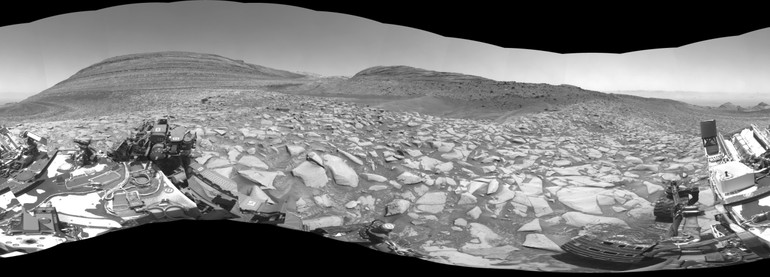NASA’s Mars rover is exploring a new region on the Red Planet
[ad_1]
The steep path of the NASA Curiosity rover is marked in yellow
Photo: NASA/JPL-Caltech/UC Berkeley
NASA’s Curiosity rover began exploring a new region of Mars – the Gediz Wallis Channel. Its study can help to find out when water disappeared from the surface of the Red Planet.
According to NASA, billions of years ago, Mars was much wetter and probably warmer than it is today.
The rover has arrived at an area of Mars where liquid water has been flowing for much longer than previously thought. He is looking for data that could explain how the channel appeared in the rock.
The slopes of this channel are quite steep, so, according to scientists, it could not have been formed under the influence of wind, but instead it could have been formed by mudflows or water flow.

A panoramic image taken by NASA’s Curiosity rover after arriving at Geddy’s Wallis Channel on February 3
According to scientists, the channel was later filled with boulders and stones that fell from Mount Sharp. It is located in Gale Crater and has a height of about 5 kilometers. Curiosity will never get there, so the team will analyze these materials to understand what the composition of the terrain might be there.
Curiosity documented the channel using a 360-degree black-and-white panorama from the left navigation camera. A picture taken on February 3 shows dark sand filling one side of the canal and a pile of debris rising behind the sand.
In the opposite direction is the steep slope that Curiosity climbed to reach the area. The rover takes such panoramas with its navigation cameras at the end of each trip.
It will take months to fully explore the channel, but what scientists eventually learn could change the way we think about when Mount Sharp was formed.
Previously, thanks to Curiosity, scientists learned that water on Mars probably appeared and disappeared periodically, and not just gradually disappeared as the planet’s climate became drier.
Last year, Curiosity made a difficult ascent to study the ridge that runs along the slopes of Mount Sharp and appears to grow from the end of the channel. Scientists noted that this is evidence that both are part of the same geological system.
We will remind you that NASA showed the “resting place” of the Ingenuity helicopter on Mars.
[ad_2]
Original Source Link











